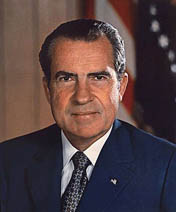The Obama administration acknowledges its highly touted accountable care organization program will have a modest early impact on the U.S. health system — with only 4 percent of Medicare beneficiaries affected by 2015

President Richard M. Nixon (White House photo)
Perhaps the Obama White House is taking a lesson from the last time a U.S. president kicked off a major new program designed to alter the way health care is delivered and paid for — President Nixon and the HMO Act of 1973. That law provided millions of dollars in start-up funding for health maintenance organizations and required employers to offer such prepaid health plans (the precursor term to HMOs), provided they were available in their community. Nixon’s role in development of HMOs was highlighted in Michael Moore’s 2007 movie “Sicko.”
Health experts credit the act for spurring the formation of hundreds of HMOs that eventually would cover nearly 60 million Americans. But most of that growth did not occur for well over a decade after the HMO Act was passed.
In the early 1970s, fewer than 4 million Americans were enrolled in nearly 40 prepaid health plans, most of which were operating in California. By 1980, about 9 million Americans were in HMOs. By 1990, that number more than quadrupled to 37 million.
Marsha Gold, a senior fellow at the nonpartisan think tank, Mathematica, said the HMO Act shows new models of health care take many years to have a big impact, and she expects the same for ACOs. “The administration may be overselling the potential of ACOs. … This could take a while.”
Like ACOs, HMOs promised to help control health spending and improve coordination of care. But their tight costs controls, which limited benefits and forced their members to use certain hospitals and doctors, led to a consumer backlash in the mid-1980s. Today, most privately insured Americans are covered by less restrictive “preferred provider organization” (PPO) plans that give patients some coverage to visit doctors and hospitals outside the plan’s network.
ACOs don’t put any restrictions on patients, and they let consumers continue to see any Medicare provider, as with coverage under traditional Medicare.
“There are a lot of parallels I see between HMOs and ACOs,” said Bob Atlas, executive vice president of consulting firm Avalere Health. “I see ACOs as the center cut of HMO – it just leaves out the enrollment lock in and fully capitated payments” — where primary care doctors get paid a set fee per member per month — “but tries to achieve the same provider care coordination that was the original premise of HMOs.”
The rush of hospitals and doctors looking to start ACOs is also reminiscent of the gold rush among entrepreneurs who moved into HMOs in the 1970s.
Judy Feder, a Georgetown University health policy professor, said the nation learned from the HMO experience that the best of intentions can have unintended consequences. “We all know HMOs from the get-go did much more to manage costs than manage care –sometimes at patients’ expense.”
She said that unlike HMOs, ACOs aim not just to change incentives, but also to change the culture of care giving. “It’s kinder, gentler and more respectful of both physicians and patients than HMOs — engaging them directly. With a lot of work and a lot of luck, it may indeed be the ticket to the better care for lower costs that’s so sorely needed.”
Brian Biles, a professor of health policy at George Washington University who was a congressional staffer involved in passage of the HMO Act, said the predominant HMOs of the 1980s and 1990s looked far different than Nixon imagined. Nixon had hoped to mimic the Kaiser Permanente model, where a non-profit organization oversees the health plan, hospitals and doctors to better coordinate care for patients.
By the 1990s, most HMOs were for-profit, national in scope and contracted with independent doctors.
“The lesson of the HMO act is that the political system and health care system takes an idea and changes it over time,” he said.






